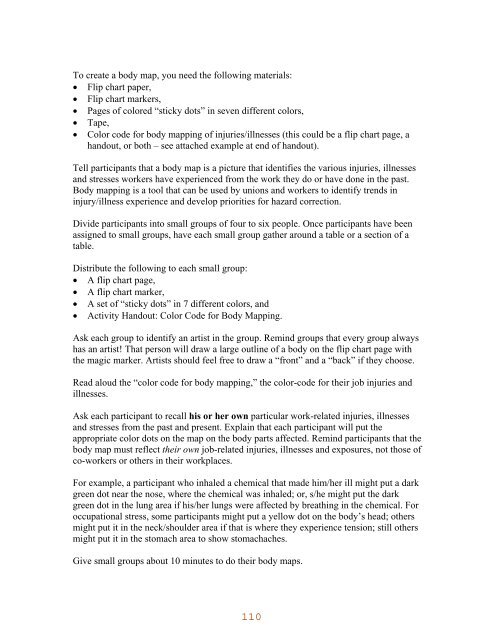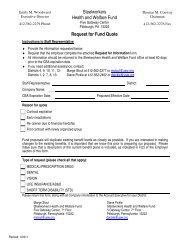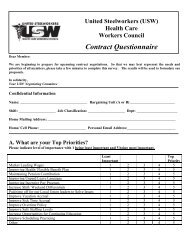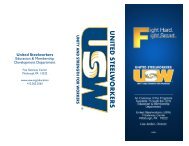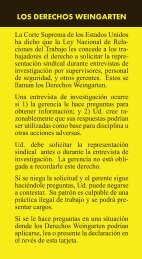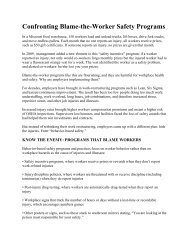Union Approach to Health and Safety: - United Steelworkers
Union Approach to Health and Safety: - United Steelworkers
Union Approach to Health and Safety: - United Steelworkers
You also want an ePaper? Increase the reach of your titles
YUMPU automatically turns print PDFs into web optimized ePapers that Google loves.
To create a body map, you need the following materials:<br />
Flip chart paper,<br />
Flip chart markers,<br />
Pages of colored “sticky dots” in seven different colors,<br />
Tape,<br />
Color code for body mapping of injuries/illnesses (this could be a flip chart page, a<br />
h<strong>and</strong>out, or both – see attached example at end of h<strong>and</strong>out).<br />
Tell participants that a body map is a picture that identifies the various injuries, illnesses<br />
<strong>and</strong> stresses workers have experienced from the work they do or have done in the past.<br />
Body mapping is a <strong>to</strong>ol that can be used by unions <strong>and</strong> workers <strong>to</strong> identify trends in<br />
injury/illness experience <strong>and</strong> develop priorities for hazard correction.<br />
Divide participants in<strong>to</strong> small groups of four <strong>to</strong> six people. Once participants have been<br />
assigned <strong>to</strong> small groups, have each small group gather around a table or a section of a<br />
table.<br />
Distribute the following <strong>to</strong> each small group:<br />
A flip chart page,<br />
A flip chart marker,<br />
A set of “sticky dots” in 7 different colors, <strong>and</strong><br />
Activity H<strong>and</strong>out: Color Code for Body Mapping.<br />
Ask each group <strong>to</strong> identify an artist in the group. Remind groups that every group always<br />
has an artist! That person will draw a large outline of a body on the flip chart page with<br />
the magic marker. Artists should feel free <strong>to</strong> draw a “front” <strong>and</strong> a “back” if they choose.<br />
Read aloud the “color code for body mapping,” the color-code for their job injuries <strong>and</strong><br />
illnesses.<br />
Ask each participant <strong>to</strong> recall his or her own particular work-related injuries, illnesses<br />
<strong>and</strong> stresses from the past <strong>and</strong> present. Explain that each participant will put the<br />
appropriate color dots on the map on the body parts affected. Remind participants that the<br />
body map must reflect their own job-related injuries, illnesses <strong>and</strong> exposures, not those of<br />
co-workers or others in their workplaces.<br />
For example, a participant who inhaled a chemical that made him/her ill might put a dark<br />
green dot near the nose, where the chemical was inhaled; or, s/he might put the dark<br />
green dot in the lung area if his/her lungs were affected by breathing in the chemical. For<br />
occupational stress, some participants might put a yellow dot on the body’s head; others<br />
might put it in the neck/shoulder area if that is where they experience tension; still others<br />
might put it in the s<strong>to</strong>mach area <strong>to</strong> show s<strong>to</strong>machaches.<br />
Give small groups about 10 minutes <strong>to</strong> do their body maps.


